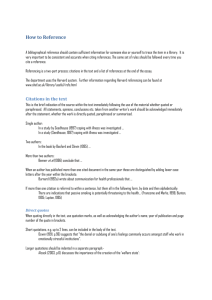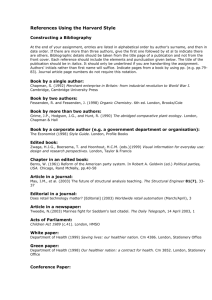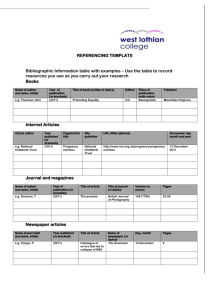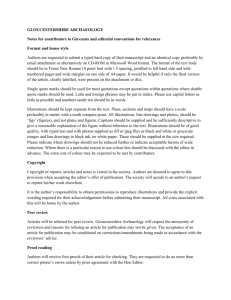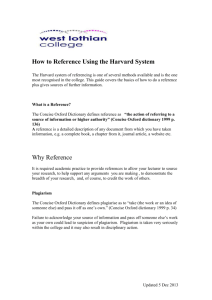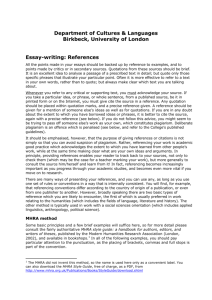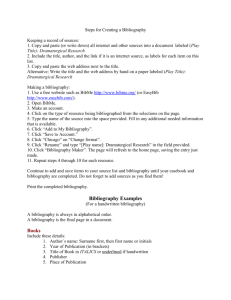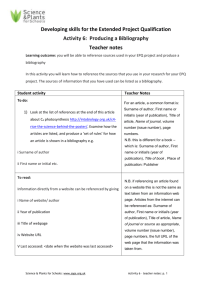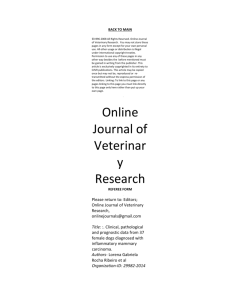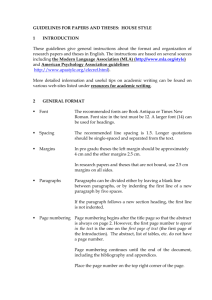Word - Oxford Brookes University
advertisement
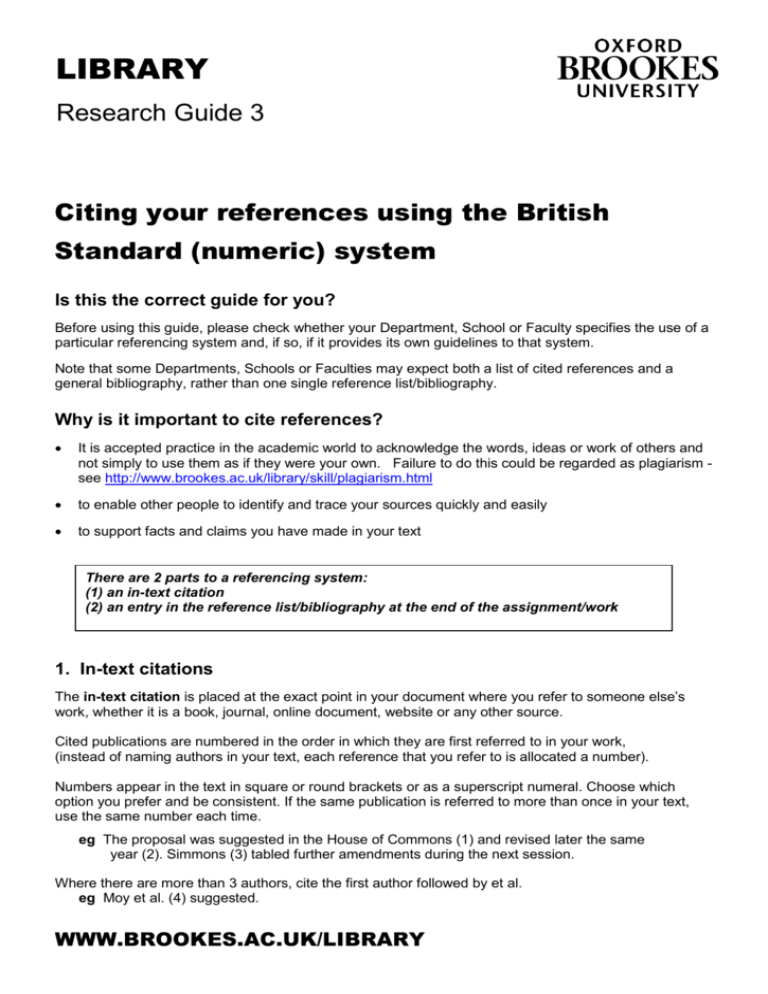
LIBRARY Research Guide 3 Citing your references using the British Standard (numeric) system Is this the correct guide for you? Before using this guide, please check whether your Department, School or Faculty specifies the use of a particular referencing system and, if so, if it provides its own guidelines to that system. Note that some Departments, Schools or Faculties may expect both a list of cited references and a general bibliography, rather than one single reference list/bibliography. Why is it important to cite references? It is accepted practice in the academic world to acknowledge the words, ideas or work of others and not simply to use them as if they were your own. Failure to do this could be regarded as plagiarism see http://www.brookes.ac.uk/library/skill/plagiarism.html to enable other people to identify and trace your sources quickly and easily to support facts and claims you have made in your text There are 2 parts to a referencing system: (1) an in-text citation (2) an entry in the reference list/bibliography at the end of the assignment/work 1. In-text citations The in-text citation is placed at the exact point in your document where you refer to someone else’s work, whether it is a book, journal, online document, website or any other source. Cited publications are numbered in the order in which they are first referred to in your work, (instead of naming authors in your text, each reference that you refer to is allocated a number). Numbers appear in the text in square or round brackets or as a superscript numeral. Choose which option you prefer and be consistent. If the same publication is referred to more than once in your text, use the same number each time. eg The proposal was suggested in the House of Commons (1) and revised later the same year (2). Simmons (3) tabled further amendments during the next session. Where there are more than 3 authors, cite the first author followed by et al. eg Moy et al. (4) suggested. WWW.BROOKES.AC.UK/LIBRARY Handling Quotations in the text Page numbers should be included when there is a need to be more specific, for example when making a direct quotation: eg As Kelvin stated (1 p.100) ‘the value of…’ Longer quotations should be separated from the rest of the text by means of indentation and optional size reduction, and do not need quotation marks: eg Simone de Beauvoir (3 p.365) examined her own past and wrote: The past is not a peaceful landscape lying there behind me, a country in which I can stroll wherever I please, and will gradually show me all its secret hills and dates. As I was moving forward, so it was crumbling. 2. Reference list / bibliography At the end of your assignment/work you need to provide a complete list of all sources used. Please note that some Departments, Schools or Faculties may expect 2 lists – (1) a reference list of all sources cited in your text and (2) a general bibliography of sources used but not specifically cited as intext citation. You can put references which you have not included in the text in a separate reference list arranged alphabetically by surname of author. References are arranged in numerical order using the same number you assigned them in the body of the text. (Note: British Standard ISO 690:2010 recommends putting authors in capitals, however common practice does not tend to follow this). Book include the following information (where possible) in the following order: Author /Editor: Surname first, followed by first name or initial/s. If there is more than 1 author, all authors should be included if possible (see eg 2 below). If any authors are omitted give the first author followed by “and others” or “et al.” If the book is edited, use ed. after the name. If there is no author (the work is anonymous), begin the reference with the title of the book. Title Capitalise the first letter of the first word and any proper nouns. Use italics for the title. Edition Only include the edition number if it is not the first. Place of publication, Publisher, Year of publication Include the place of publication, followed by the publisher, followed by the date of publication. Pages If quoting a specific section include the pages where the quote occurs. Insert the abbreviation pp. before the page numbers (p. if a single page). eg 1. Pilcher, J. Age and generation in modern Britain. Oxford: Oxford University Press, 1995. eg 2. Hitchcock, Tim and Michele Cohen, eds. English masculinities, 1660-1800. London: Longman, 1999. eg 3. Connell, Raewyn. Masculinities. 2nd ed. Cambridge: Polity, 2005. 2 E-book include the following information (where possible) in the following order: Author: follow guidelines above (under book) Title: follow guidelines above (under book) [Online] in square brackets Place of publication, Publisher, Year of publication [Accessed] in square brackets with the date you viewed it - (you may also use [viewed]) Available from: URL (this should be the URL of the e-book collection if it is from a collection). eg Neville, Colin. The complete guide to referencing and avoiding plagiarism [online]. Maidenhead: Open University Press, 2007, [Accessed 11 June 2011]. Available from: http://www.dawsonera.com/ Chapter in an edited book Include the following information: author of chapter (last name followed by initial), chapter title, In:, author of book the chapter is from (initial/s followed by last name), title of book (in italics), place of publication, publisher, year of publication, page numbers. eg Franklin, A.W. Management of the problem. In: S.M. Smith, ed. The Maltreatment of children. Lancaster: MTP, 2002, pp.83-95. Journal article (in print / paper format) Information can usually be found at head of article or contents page. Remember if you have referred to a journal article in your text, number the reference to match its number in the text. Author As for books – see pg.2. (use last name followed by initial/s for first author, use initial/s followed by last name for other authors) Title of article Use the title given at the beginning of the article. Title of journal Use the title given on the front of the journal and use italics. Year of publication If applicable record the month as well as year. Volume and Issue or part number Include volume number (in bold) and issue number (in brackets) if applicable Pages As for books – see pg.2. eg King, A. Football fandom and post-national identity in the new Europe. The British Journal of Sociology, 2000, 51(3), pp.419-442. eg Cooper, S. Almost tomorrow. Book and Magazine Collector, July 2006, no.270, pp.51-61. Electronic / Online Journal article Same as for printed journal article AND ALSO INCLUDE: [Online] in square brackets after the journal title [Accessed] after the page numbers (in square brackets with the date you viewed it) Available from (this should be the URL of the e-journals collection if it is from a collection). eg Francis, Becky. University Lecturers' Perceptions of Gender and Undergraduate Writing. British Journal of Sociology of Education [online], 2003, 24(3), pp. 357-373. [Accessed 3 September 2011]. Available from: http://ejournals.ebsco.com/ 3 Newspaper articles eg Bailey, M. Hopes for ports reorganisation despite dock labour squalls. Times, 29 May 1975, p.21. Online newspaper article: include the following information (where available) in the following order: author, article title, newspaper title, [online] after the newspaper title, date accessed (Accessed in square brackets with the date you viewed it), page number, Available from: (include url or newspaper collection if it is from a collection). Film, video or broadcast eg Dave Allen at large, BBC TV, 25 February 2006. eg Dimbleby, David. Any questions. BBC Radio 4, 4 March 2006 eg Casablanca [film]. Directed by Michael Curtiz. UK: Warner, 1999. Conference Papers eg Robertson, J. The economics of local recovery. In: The other economic summit, 17/18 April 1986, Tokyo. London: The Other Economic Summit, 1986, pp.5-10 Website Take the information from the website itself or the associated homepage: eg Labour Party. Policy guide [online]. 2010. [Accessed 3 September 2011]. Available from: http://www.labour.org.uk/policies/home Personal Communication (email, letter conversation) Include name (of sender, author, speaker), method of communication and receiver (in italics), date. eg Saunders, L. Email to Linda Hinton, 18 August 2007. Further reading: Bosworth, D. Citing your references: a guide for authors of journal articles and students writing theses or dissertations. Abergavenny : GSSE, 2004. British Standards Institution. Information and documentation — Guidelines for bibliographic references and citations to information resources. London: BSI, 2010 (BS ISO 690) British Standards Institution. Recommendations for citing and referencing published materials. London: BSI, 1990 (BS 5605). British Standards Institution. Recommendations for citation of unpublished documents. London: BSI, 1983 (BS 6371). Dees,R. Writing the modern research paper, 3rd ed. Boston: Allyn & Bacon, 2000. EndNote: You can use EndNote, a reference management service, to build up a database of your references. EndNote will automatically format the citations in your text and the references in your bibliography in the style you need. EndNote is available both via the Web and on Library and pooled room computers. For full details see: http://www.brookes.ac.uk/library/endnote.html Helen Whittaker, OBU Library, 1/13 4

